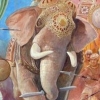-
Posts
532 -
Joined
-
Last visited
-
Days Won
3
Everything posted by lilstewie
-
Movie on the early Cholas. http://en.wikipedia..../Karikala_Chola http://en.wikipedia....ki/Ilamcetcenni http://en.wikipedia....arikalan_(film)
-
Another Maurya fort. Jaugada Layouts are similar to the other two found. Sisupalgarh Mahasthangarh
-
Some sort of palace. Satavahana made reliefs A siege http://en.wikipedia.org/wiki/Sanchi Chariot horse elephant http://puratattva.in/2012/03/21/sanchi-buddham-dhammam-sangham-4-1478.html
-
self delete
-
http://www.france24....sh-ancient-city http://en.wikipedia....i/Mahasthangarh The citadal's design and placement is similar to Sisupalgarh. Source: http://www.thedailys....php?pid=125979 Source: http://www.thedailys....php?nid=175698 Bricks no doubt were in use in the Mauryan period.
-
Ariel view of the Sisupalgarh.
-
Good link http://www.penn.muse...14-2/Thapar.pdf Take a look. Look at the B.C. stuff. Mauryan, Sunga, etc stuff in Delhi. Terracotta figurine of a horsemen with armor, Mauryan period. But can't really tell what type. -Sunga period Sungas being one of their successors. Obviously carried on a lot of the Mauryan style, methods, etc.
-
More in the link source: http://www.sdstate.e...c-India-Ray.pdf
-
Bricks were used for sure. http://Sisupalgarh http://en.wikipedia.org/wiki/Tosali
-
Understood Rahul. From the previews they released. Mauryans looks so kewl.
-
I think they're doing a brilliant job with what they got from the reliefs. All the models looks fine to me.
-
I think the guys making the building models pretty much got it covered.
-
You guys have done an excellent job. I love the buildings. Tell us when you guys will show more previews.
-
A spearmen, and a swordsman with scale armor, dhoti, etc. 1st century A.D. Butkara Stupa Mathura spearmen, around 1 century A.D. King Vijaya landing in Ceylon(Sri Lanka) Excellent image of an Indian city in antiquity. Supported by the many reliefs. Sangamitta landing in Sri Lanka
-
And the Talwar was a superior cavalry sword compared to the Khanda. Indian cavalry preferred the Talwar.
-
@Rahul The Khanda is the pre-Talwar sword of India. But the hilt with the hand guard would need to be replaced for this era. I dont think you can see the hilt in the game anyways. I haven't seen any surviving painted relief from India or from the carvings in Indianized kingdoms in South East Asia. I don't know for sure.
-
Because the Talwar was more widespread in the post Islamic invasion of India. It's just heavier than the curved swords from the Middle East. I've heard all of the curved swords like the scimitar, kilij, scimitar, etc came about after the Mongol invasion. You won't find anything like the scimitar in India, Persia, Arabia, or Anatolia at this time. Nothing is set in stone. All religions fight eventually when they're pushed. Look at those Buddhist in Burma fighting now. Or the Buddhists in Sri Lanka in the civil war. No, but it gives an idea of how the architecture would've been like. The palaces wouldn't be cut from a cliff and would've been huge.. The rock cut ruins survived after 2000+ years, while the wooden, etc. architecture didn't.
-
Bronze scale. Ajanta Cave. \ Sunga period. Various buildings and building styles can be seen in these carvings. http://www.europeana...C5.html?start=4 Supposedly this is a Indianized Buddhist Greek warrior. Image of a medieval Indian elephant used as a siege weapon Hey guys, please don't give any soldiers scimitars, or Talwar. I know this example above doesn't have too much detail other than the fact it's a two masted sailing ship. But this 9th century Indonesian carving of a two masted ship may be of some interest. As you may or may not know. South East Asia back then was heavily influenced by Indian art, architecture, etc, etc. It very well could be a depiction of Indian traders, who historical have been trading with that part of the world for 1000s of years. source: http://www.frontline...18262506200.htm http://johnlbradfield.com/history/gold-in-south-africa-and-the-ancient-indian-connection/
-
smaller boat ^^^ Above is an amazing find. Thank you to the member for sharing thst link with this image. This image shows a siege/battle scene in Indian antiquity(top right). This is incredibly rare thing to find. Sense must depictions are 97% of the time religious in nature. And not a lot survives. You see a lot of the infrastructure, like the towers, gate, etc.
-
Another successor of the Mauryans. The Kalingas. The Kalingas under Emperor Kharavela made a short comeback after the Mauryan empire dissolved. After Kharavela died, the empire dissolved. http://en.wikipedia.org/wiki/Kharavela The Kalingas took much of India. They even came very close to battling the Indo-Greeks, and fought many of the Mauryans successors like Saravahana. http://www.herenow4u...ex.php?id=76893 Bas relief at Udayagiri cave. battle scene, Rani Gumpha The style of clothing is similar to the other Mauryan successors.(Sunga, Saravahana, etc)
-
chaitya-griha, rock cut architecture Sanchi
-
I don't think they should take a lot of things from the Kushans for the Mauryans. It makes sense getting an idea from the Sungas, Satavahana, etc. Kushans are too much of a blend of things from Central Asia, India, Persia, Greeks, etc. Btw, if you want a good source, You should look at Chanakya's Arthashastra. Chanakya was the priest who lead Chandragupta to over throw the Nandas. http://en.wikipedia.org/wiki/Arthashastra It'll be a good source. It does talk about armor and stuff in there, but it's mostly about economic policies and how to upkeep an empire. Sorry if this was posted before.
-
Yeah, fantasy is a better word for it. And bare chested was the way to go for men and women. But some wore clothing on top. But this was more common it seems in Indian antiquity. I could be wrong, Sunga period
-
^^^ This is a later evolution. ^^^ Too medieval. What is that plate armor? As far as armor goes in ancient India. I believe it's scale armor. And that was not so common.
-
Stupa from the Satavahana dynasty. Another supta from the Maurya-Sunga period. Stupa recreated from the satavahana period. What do you mean by crown? Like this Persian sculpture? Because I've never seen such thing from India. Here are images of females from the Mauryan-Sunga period. High class women. Satavahana period Lower class and court women.


